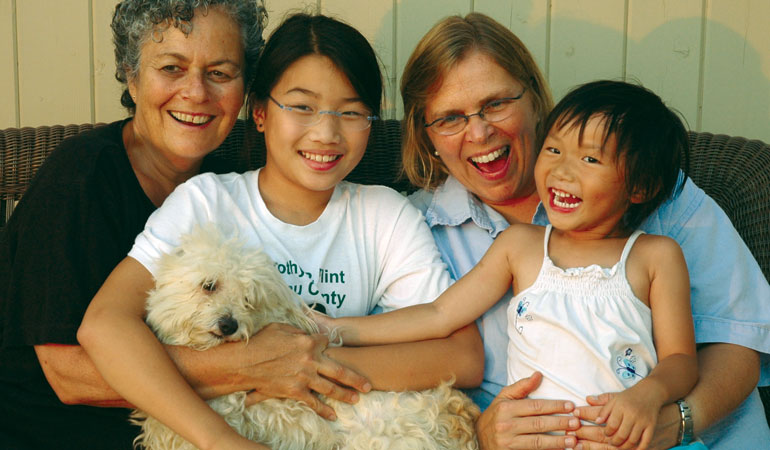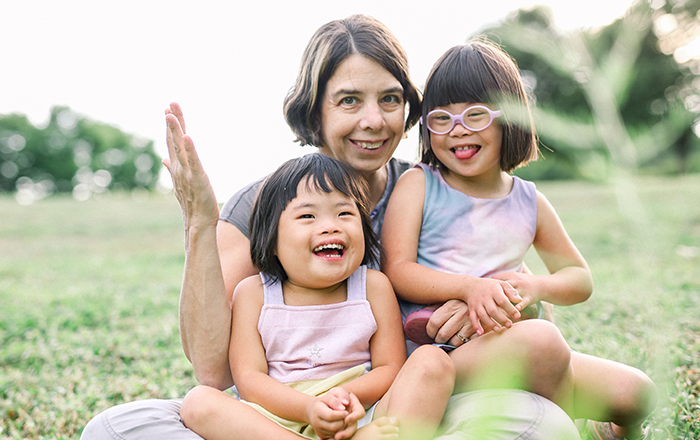Today’s families come in all shapes and sizes, from Leave It to Beaver‘s Mom and Pop model to “nontraditional families” raised by lesbian or gay partners or a single mom or dad.
According to the Census Bureau, between six and 10 million American children lived in gay, lesbian, or bisexual households in the year 2000. Single parents were heads of household in 27 percent of all families with children under the age of 18.
Unfortunately, our society isn’t as open-minded as many of its families are. Whether it’s questions from classmates or school assignments that don’t fit their family makeup, single-parent and gay and lesbian-parented families face challenges beyond those of the mom-and-pop adoptive family. Here’s how some of these families have dealt with the additional attention they receive.
Speak Up for Your Family
In generations past, adoption, single parenthood, and homosexuality were often treated as sad secrets. But today, people are proud and outspoken about their “alternative” family makeup.
Steven Salinas, a single, gay dad in Sacramento, California, had plenty of support from friends and family members when he adopted his son from foster care. So he was taken aback when he overheard, at a child’s birthday party, one couple questioning his worth as a parent. Salinas walked up to the pair, took his 19-month-old toddler out of the woman’s arms, and told the man that he was fully capable of raising his son.
“If you do not intend to be part of or supportive of the solution,” Salinas told the man, “please do not be part of the problem.”
To this day Salinas remains calm about the event. “I truly believe that it is up to us to educate our society, and to advocate for ourselves and our families,” he says.
As children get older, parents need to teach them to speak up for themselves. “There is a lot more homophobia than anti-adoption messages in our society,” says Mary Nealon, who is raising two daughters with her partner, Vivian Shapiro. “I am concerned that these messages will take a toll on our daughters’ self-esteem and feelings about their family.”
Nealon and her partner worked with their daughters to come up with ideas for answering the hurtful questions kids often ask. In doing so, they found that many of the lessons taught to children about handling adoption-related questions can be adapted to handling questions about a nontraditional family structure.
For instance, kids can deflect questions about their two mommies or lack of a father in the same way that they’d stop prying queries about their birth family — by saying something like “That’s personal” or “Why do you want to know?” Says Nealon, “We do our best to teach what’s acceptable to say and not say, and what’s acceptable to have to listen to.”
Work with the Holidays
Holidays like Mother’s Day and Father’s Day, which often involve special art projects in elementary schools, can be awkward for children who don’t have a father or a mother to celebrate — or who have two mothers (or fathers), and are only allowed to make one special craft.
Most teachers have allowed Nealon’s older daughter to create two gifts, for her two mothers, on Mother’s Day. But when one teacher forgot, it caused a lot of anxiety for their daughter. Father’s Day is less of a problem. “Each year, we ask her which special someone in her life she’d like to make a Father’s Day gift for. She usually picks an uncle or an older cousin.”
Angela Anderson, a California mom who adopted an eight-year-old girl from Russia two years ago, has found Father’s Day trying. “Last year was difficult, because her class was making gifts,” Anderson says. “I told her to make something for Grandpa next year, because Grandpa is a dad, too.” Other families have had their children create Father’s or Mother’s Day gifts for godparents or other special people in the child’s life.
Use Positive Phrases
Language is deeply tied to social change and self-definition. The adoptive community experienced this in the last few decades, as it worked to change “real parent” into “birth parent,” and as parents sought the language and stories to express their children’s backgrounds positively.
“We use phrases like ‘There aren’t any daddies at our house,'” says Amy Wheeler. “Or ‘Your birth daddy lives in Guatemala, but there aren’t any daddies at our house.'”
Wheeler and her partner regularly talk about different types of families so their son will learn to recognize similarities as well as differences. “We hope that, as he gets older and starts to compare himself with others,” says Wheeler, “he’ll have the vocabulary to describe and stand up for his family.”
When children are young, simple things can work. Michael Patrick and his partner, parents to a toddler girl and a baby boy, started to deal with the language question last year, when their daughter began asking about her mother. “At this point we decided to say she had a Papa and a Daddy instead of a Mommy and Daddy,” Michael says. “She liked that.”
Of course, this becomes a bigger challenge as children grow older and begin to pick up on negative messages about their family from the outside world. For Nealon and her partner, being very involved — and very public — figures at their children’s school and house of worship has helped. “We do our best to be positive role models, and we are accepting of all other types of families we meet,” she says. “Fortunately, we’ve been involved in a progressive, reform temple that has been extremely welcoming to us as a family, and our children have attended progressive schools.”
Talk to Teachers
Teachers can play an important role in educating your child — and his peers — about family structures. Schedule a meeting with your child’s teachers early in the school year to help educate them about positive language and the varieties of family makeup. While many teachers are wonderful educators and mentors, “Some use language without awareness,” says Peggy Gillespie, co-director of “Love Makes a Family,” a touring photo exhibit that celebrates diversity. According to teenagers Gillespie has interviewed, teachers who would not tolerate any racist comments in the classroom will sometimes say nothing about a gay slur. Other teachers will make comments like “Ask your mom and dad” without thinking about it.
And then there is the family tree project. Many adoptive children have skillfully navigated this potentially sensitive activity. A mother whose family is composed of herself, two fathers who are gay, and two children adopted from China, says her daughter takes an inclusive approach: “She just uses all of our families’ histories as her own.”
Although many parents don’t object to the family tree project, Gillespie is firm about considering alternatives. It matters “even if it hurts only one child,” she says.
Pat Barbieri, single mom to a daughter adopted from Guatemala, alerts every new teacher to the fact that she is a single mom, and that her daughter was adopted. “I ask them to remember that fact when they plan projects and events during the year, and, with few exceptions, they have remembered.”
Appreciate Differences
In teaching your kids to be proud of their family’s uniqueness, help them to see the similarities to and differences between them and their peers — and to celebrate each person’s unique background. “Kids grow strong if they have parents who are behind them,” Gillespie says. “Whatever differences they have, I see it as an opportunity for the kids to become great adults with compassion for all people.”
Someday, perhaps, our society will recognize all families for what and who they are: something far greater than a biological sum. Until then, nontraditional families are making amazing progress on their own.


